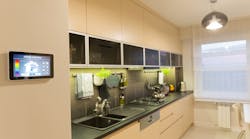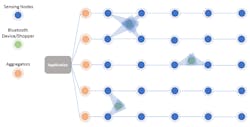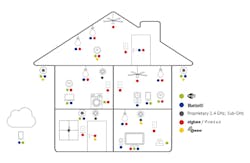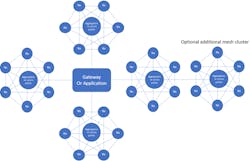With the rise of the Internet of Things (IoT), we’ve seen a growing trend toward collecting and aggregating sensor data for a wide array of smart-home, industrial, green-energy, transportation, and smart-city applications. The general belief across the industry was the more data sent to the cloud or to a local control system, the better.
Much of this sensor data was in the form of physical sensing for human occupation, object detection, temperature, humidity, light, sound, and vibration. Over time, developers realized the difficulty of deploying large sensor networks, and many cloud companies concluded that access to vast amounts of data doesn’t necessarily add value if you can’t act on that data for decision-making.
In today’s cost-sensitive environment, every deployed sensing device or network must balance the complexity of development and deployment with the value delivered to IoT service providers, cloud companies, and end users. We’re now seeing a trend in deployed sensor networks of simplifying the network and measuring only what can be translated into cost savings and/or a more positive end-user experience.
Sensor Network Trends and Use Cases
Let’s consider two use cases that exhibit the emerging trend of deploying the optimal number of sensors required by the IoT application: a retail store and a commercial office building.
A store’s most valuable real estate is its merchandise shelves, and a key metric is customer conversion. Most large retailers would benefit from a sensor network measuring occupancy, customer and item location, inventory level, and more. Ideally the system would use sensor data to increase the likelihood of customer purchases. The sensors could use new Bluetooth tracking technology such as angle of arrival (AoA) and angle of departure (AoD) as well as received signal strength indicator (RSSI) or phase shift for distance.
Such AoX (Fig. 1) and distance technologies enable the network to triangulate the position of a customer’s smartphone or a device embedded in the shopping basket/cart to detect the customer’s location and where shoppers spend their time in the store. This data combined with facial-recognition technology or smartphone identification could assign a portfolio to each shopper anticipating items they’re most likely to buy and either offer in-store sales or bundles to incentivize them or deliver targeted marketing campaigns after in-store visits.
1. Angle of Arrival and Angle of Departure (AoX) technology, supported by Bluetooth 5.1, enhances the development of indoor positioning systems.
The optimized sensor network could also provide store managers with insights into buying decisions for various product types. For example, the sensor network might reveal that certain customers spend a lot of time comparing toothpaste brands while acting quickly with shampoos, choosing a brand they know. This information enables the store to intelligently stock their shelves with items customers are more likely to purchase, increasing the store’s efficiency and profitability.
Converting an office building into a sensor-laden smart building will reduce maintenance and operating costs and enhance safety, comfort, and convenience for its occupants. Climate control is a major cost factor for facilities management. It can cost more than $50,000 a month to adequately cool or heat a typical 100,000-square-foot building. Cutting this cost by 15% by adding a $300,000 smart sensor network would be a wise investment, paying for itself in a few years.
Another valuable addition would be a sensor network optimized for damage avoidance. The ability to sense threats such as water leaks, flooding, smoke and fire and then react quickly can save significant repair cost while protecting occupants and even saving lives. Threat reduction through sensor networks could also reduce insurance premiums.
While these two sensor network examples can directly enhance the deployer’s top or bottom line revenue, there are two key challenges to consider when implementing a sensor network: the physical medium for deployed sensors and how the sensor data is handled.
The Physical Medium
Every sensor network is configured differently, depending on the application requirements and physical environment. For example, some networks may be deployed in retail environments with uniform coverage while others may be implemented in corporate offices with varying room sizes. Some networks may be used 24/7 while others are active partially on a given day. A factory plagued with electromagnetic noise from motors can be a challenging environment for sensor networks, making some types of sensing or communication techniques impossible. Each of these scenarios requires an optimal sensing solution.
Consider the example of a commercial building. A common goal is to reduce energy consumption and cost for lighting and HVAC systems. There are two options: minimize lighting and HVAC usage in areas with little to no occupancy or implement power-efficient modes of lighting and climate control. With either option, deploy sensor types that are absolutely necessary, such as occupancy, light level, and temperature sensors. Additional sensors for humidity or pressure can add more confidence by ensuring that occupants aren’t negatively impacted by optimizing lighting and climate controls.
To deploy an optimal sensor network, the developer must make a few decisions upfront:
“Will the sensing nodes be battery powered or wired?”
A battery-powered wireless sensor node is easier to install as there are no power lines to run. But battery replacement every few years can negatively impact the ROI equation. Running power lines (mains or power over Ethernet) can also be an expensive upfront cost, and local code compliances vary by region. Deploying a low-voltage system like PoE can be more cost-effective than running 110 V or 220 V to every sensor node. Another economical option is to install low-voltage LED lighting along with the sensor network for easier access to energy savings.
“Will the sensing node use wired or wireless communication?”
The solution depends on the tradeoffs of using wired power and wired data communications versus battery power and wireless data. Wireless can be cost-effective since there’s no need to run data lines throughout a building, but other upfront engineering costs and complexities must be considered when implementing a wireless network. For new construction, it’s very easy to run CAT5, which can pass data and power to every node.
With CAT5 wire, the data rate can be lower than the typical 1 Gb/s, meaning the CAT5 cable can run more than 100 meters. However, for some building renovations, accessing hard-to-reach places to run cable such as dropped ceilings can be nearly impossible. In such cases, wireless connectivity may be the best option.
When implementing a wireless network, developers must consider which medium and protocol to use. Wi-Fi is attractive from its ease-of-use due to the pervasive infrastructure and familiarity of IP packets, but Wi-Fi can only support a limited number of end nodes and access points and consume lots of power compared to other short-range options. While Zigbee solves the power problem, developing a Zigbee network may be challenging for developers who lack mesh expertise. The deployer will need to gauge the strengths and drawbacks of each protocol choice (Fig. 2) to determine the best path. There’s no perfect solution. The best wireless choice is one where tradeoffs can be tolerated to achieve optimal application goals.
2. Developers have a wide choice of short-range protocols for wireless-sensing applications used in building automation.
“Where will decisions based on sensor data be made?”
Depending on the requirements of a commercial building or home, the decision to turn an HVAC system on or off can be made locally within the building by an HVAC controller. Alternatively, the sensor data can be sent to the cloud for processing, enabling remote control of the HVAC system.
This choice of local or remote data processing and control depends on many factors, including the complexity of the computations required for decision-making, how much data must be processed, and if post data processing or remote monitoring are needed. Local processing and control may be feasible for a smart home with limited data requirements. However, managing an HVAC system for a building with many rooms may require a gateway to transmit data to the cloud.
Handling Sensor Data
Handling the data generated by hundreds of sensor nodes is a showstopper for many developers attempting to deploy large-scale sensor networks. Setting up a few nodes in a lab and getting them to communicate to a host or the cloud is relatively simple, but the network design becomes exponentially difficult as the number of nodes increases.
The application that collects local or cloud-based data must identify and time-stamp all data to build an accurate model of the building. For a smart office, a host system will receive data from hundreds of sensors. This can be an unrealistic, expensive, and difficult problem. While a sensor on each end node may cost only $0.50, the requirements for a mesh network and cloud computation overhead may far outweigh the cost of the sensors. Experienced sensor network deployers are now adding only what’s absolutely required to each end node. This rightsizing approach cuts data overhead and reduces the power consumption of end nodes, which can save battery-replacement cost.
Network topology is a multivariable problem. A trending solution is to use a hybrid topology that combines a mesh network with a bus or tree topology. For example, in a smart office, it makes sense to deploy many smaller sensor mesh networks that can leverage each other to hop messages that reach an aggregator or an access point (Fig. 3). This access point can be part of another mesh network that’s one step away from the host or includes the host and other aggregators. Using these “middle” nodes simplifies a difficult problem by essentially splitting the work between the aggregators and the host.
3. Smart offices can deploy smaller sensor mesh networks that leverage each other to hop messages that reach an aggregator or access point.
By using a hybrid topology, the cloud can receive organized data, easing the burden on the cloud application and enabling a more scalable network. The cloud application will most likely be customized for the specific task and must be created or licensed to provide monitoring capabilities for the building.
The current trend is to implement such an application through “software as a service” (SaaS). For example, an insurance company wishing to cut HVAC cost usually doesn’t have the core competence to develop this application on its own. The application provides feedback and configurations that facility managers can use to custom-control their building environments to their liking.
Conclusion
Sensor networks can be a challenge to deploy. No one sensor network layout or measurement portfolio fits every IoT application. One network may focus on tracking assets or people, while another prioritizes sensing environmental changes to cut cost or avoid disasters. Whichever sensor network approach is chosen, it must bring value. This value must offset the cost and complexity of the physical medium in which it’s deployed as well as the system that’s deployed to handle the data and ultimately make decisions.
Deploying a sensor network must be carefully planned from battery-powered end nodes to large-scale cloud-based applications. When deploying or designing a sensor network, consider all aspects—even the slightest oversight can cause insurmountable tradeoffs. Consider how each sensor node will be powered, how data will be transferred and its path to the host application, and how the network will be serviced or scaled up over time. Sensor networks are beginning to achieve optimal value-to-cost ratios, and more businesses will deploy them to reduce cost, gain intelligence, and differentiate from the competition.
Mark Beecham is MCU and Sensor Product Manager at Silicon Labs.





